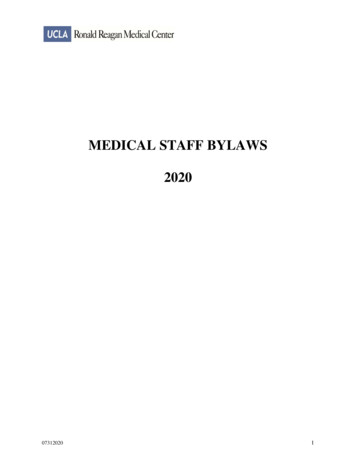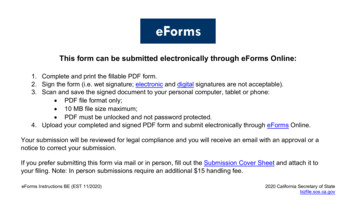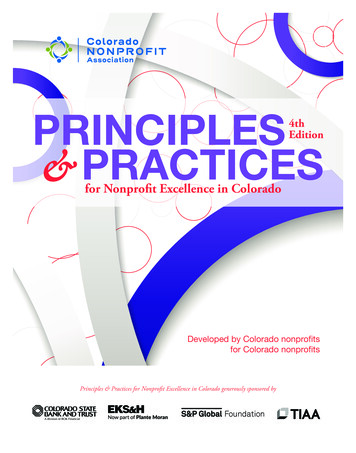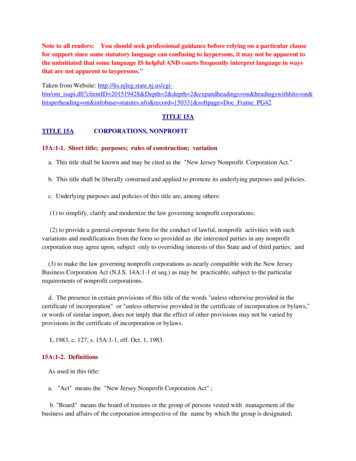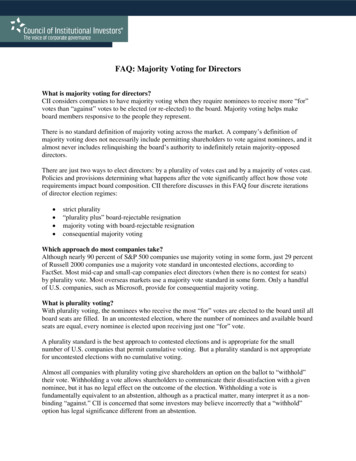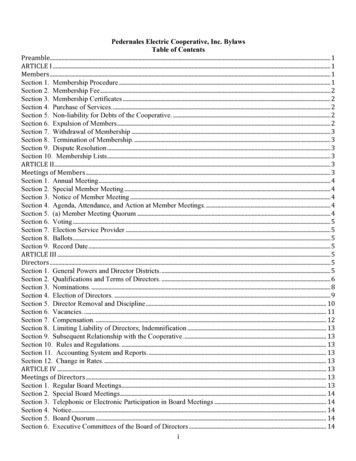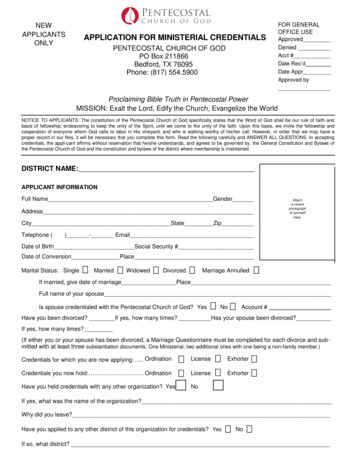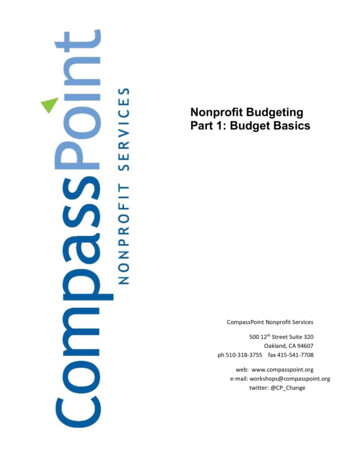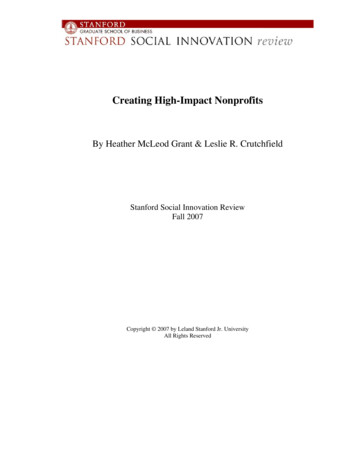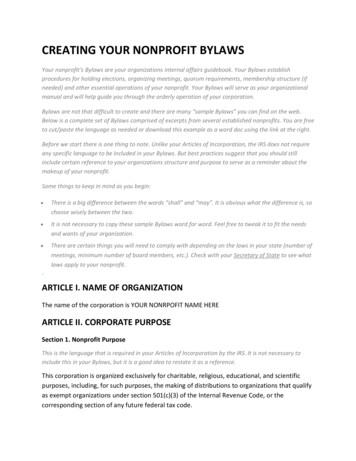
Transcription
CREATING YOUR NONPROFIT BYLAWSYour nonprofit’s Bylaws are your organizations internal affairs guidebook. Your Bylaws establishprocedures for holding elections, organizing meetings, quorum requirements, membership structure (ifneeded) and other essential operations of your nonprofit. Your Bylaws will serve as your organizationalmanual and will help guide you through the orderly operation of your corporation.Bylaws are not that difficult to create and there are many “sample Bylaws” you can find on the web.Below is a complete set of Bylaws comprised of excerpts from several established nonprofits. You are freeto cut/paste the language as needed or download this example as a word doc using the link at the right.Before we start there is one thing to note. Unlike your Articles of Incorporation, the IRS does not requireany specific language to be included in your Bylaws. But best practices suggest that you should stillinclude certain reference to your organizations structure and purpose to serve as a reminder about themakeup of your nonprofit.Some things to keep in mind as you begin: There is a big difference between the words “shall” and “may”. It is obvious what the difference is, sochoose wisely between the two. It is not necessary to copy these sample Bylaws word for word. Feel free to tweak it to fit the needsand wants of your organization. There are certain things you will need to comply with depending on the laws in your state (number ofmeetings, minimum number of board members, etc.). Check with your Secretary of State to see whatlaws apply to your nonprofit.ARTICLE I. NAME OF ORGANIZATIONThe name of the corporation is YOUR NONRPOFIT NAME HEREARTICLE II. CORPORATE PURPOSESection 1. Nonprofit PurposeThis is the language that is required in your Articles of Incorporation by the IRS. It is not necessary toinclude this in your Bylaws, but it is a good idea to restate it as a reference.This corporation is organized exclusively for charitable, religious, educational, and scientificpurposes, including, for such purposes, the making of distributions to organizations that qualifyas exempt organizations under section 501(c)(3) of the Internal Revenue Code, or thecorresponding section of any future federal tax code.
Section 2. Specific PurposeHere you put the purpose of your organization as well as the specific activities you will be involved in. It isa good idea to list the major activities of your nonprofit without being too specific about the details. Youwant to have a focused scope of work without limiting the ability to grow the organization in the future.The following sample is from Noble Paws, Inc. in Fairbanks Alaska.Noble Paws provides dog sled training and services for persons with special needs, disabilitiesand at-risk behaviors. This service includes the use of a trained dog sled team and handicapaccessible dog sleds. The sleds are modified and/or custom made to accommodate the specificneeds of the participants.The specific objectives and purpose of this organization shall be:a. to provide instruction in the sport of dog mushing to persons with special needs,disabilities and/or at-risk behaviors;b. to provide facilities, equipment and a trained dog team for participants to engage in thepromotion and participation of the sport of dog mushing;c. to provide opportunities for participants to engage in recreational, competitive andbackcountry mushing;d. to sponsor, host and/or participate in events and activities that promote the sport ofdog mushing.ARTICLE III. MEMBERSHIPMembership in your nonprofit can be limited to your board of directors or it can also include members ofthe public. This is a decision you will have to make at your first meeting when you adopt your Bylaws.The following example outlines requirements and governance of a nonprofit that is open to publicmembership. It is extracted from the Minnesota Council of Nonprofits Sample Bylaws with Membership.If you do not intend to have pubic membership, then the following wording is all that is necessary:The membership of the corporation shall consist of the members of the Board of Directors.Section 1. Eligibility for MembershipApplication for voting membership shall be open to any current resident, property owner,business operator, or employee of the REGIONAL AREA (IF NECESSARY) that supports thepurpose statement in Article II, Section 2. Membership is granted after completion and receiptof a membership application and annual dues. All memberships shall be granted upon amajority vote of the board.
Section 2. Annual DuesThe amount required for annual dues shall be XXX each year, unless changed by a majorityvote of the members at an annual meeting of the full membership. Continued membership iscontingent upon being up-to-date on membership dues.Section 3. Rights of MembersEach member shall be eligible to appoint one voting representative to cast the member’s votein association elections.Section 4. Resignation and TerminationAny member may resign by filing a written resignation with the secretary. Resignation shall notrelieve a member of unpaid dues, or other charges previously accrued. A member can havetheir membership terminated by a majority vote of the membership.Section 5. Non-voting MembershipThe board shall have the authority to establish and define non-voting categories ofmembership.ARTICLE IV. MEETINGS OF MEMBERSIf you do not have public membership you can skip this Article.Section 1. Regular MeetingsRegular meetings of the members shall be held quarterly, at a time and place designated by thechair.Note: A membership nonprofit should hold at least one (1) member meeting each year. Some states mayrequire more. Check with your Secretary of State to see if any state statutes apply to member meetings.Section 2. Annual MeetingsAn annual meeting of the members shall take place in the month of October (pick a month), thespecific date, time and location of which will be designated by the chair. At the annual meetingthe members shall elect directors and officers, receive reports on the activities of theassociation, and determine the direction of the association for the coming year.Section 3. Special MeetingsSpecial meetings may be called by the chair, the Executive Committee, or a simple majority ofthe board of directors. A petition signed by five percent (5%) of voting members may also call aspecial meeting.Section 4 Notice of Meetings
Printed notice of each meeting shall be given to each voting member, by mail, not less than twoweeks prior to the meeting.Section 5. QuorumA quorum for a meeting of the members shall consist of at least twenty percent (20)% of theactive membership.Note: You can set the quorum requirements for member meetings in your Bylaws and/or yourArticles of Incorporation. Check with your Secretary of State office to see if what quorumrequirements may apply to your member meetings.Section 6. VotingAll issues to be voted on shall be decided by a simple majority of those present at the meetingin which the vote takes place.ARTICLE V. BOARD OF DIRECTORSYour board of directors are members of your organization. But they are given special responsibilities andauthority. If there is one section of your Bylaws that you will be referencing frequently, this is it.The following excerpt is from the ASPCA’s sample shelter Bylaws.Section 1. General PowersThe affairs of the Corporation shall be managed by its Board of Directors. The Board ofDirectors shall have control of and be responsible for the management of the affairs andproperty of the Corporation.Section 2. Number, Tenure, Requirements, and QualificationsThe number of Directors shall be fixed from time-to-time by the Directors but shall consist of noless than three (3) nor more than fifteen (15) including the following officers: the President, thefirst Vice-President, second Vice-President, the Secretary, and the Treasurer.Note: Check with your Secretary of State to see the minimum number of board members required in your state.The members of the Board of Directors shall, upon election, immediately enter upon theperformance of their duties and shall continue in office until their successors shall be dulyelected and qualified. All members of the Board of Directors and Advisory Council must beapproved by a majority vote of the members present and voting. No vote on new members ofthe Board of Directors, or Advisory Council, shall be held unless a quorum of the Board ofDirectors is present as provided in Section 6 of this Article.
No two members of the Board of Directors related by blood or marriage/domestic partnershipwithin the second degree of consanguinity or affinity may serve on the Board of Directors at thesame time.Each member of the Board of Directors shall be a member of the Corporation whosemembership dues are paid in full and shall hold office for up to a three-year term as submittedby the nominations committee.Newly elected members of the Board of Directors who have not served before shall serve initialone-year terms. At the conclusion of the initial one-year term, members of the Board ofDirectors may serve additional three year terms. Their terms shall be staggered so that at thetime of each annual meeting, the terms of approximately one-third (1/3) of all members of theBoard of Directors shall expire.Each member of the Board of Directors shall attend at least nine (9) monthly meetings of theBoard per year.Each member of the Board of Directors shall contribute at least one hundred cash dollars( 100) to the organization annually, all or part of which may come from the tax deductiblevalue paid for or solicited by the Board member, and received by the Corporation. Nocontribution credit shall be given for in-kind donations. Provided, however, that the 100 cashrequirement for any member who joins after the beginning of the fiscal year for his or her initialone-year term shall be prorated accordingly.Note: As with many things in the Bylaws, it is your choice on what to include as criteria for your boardmembers. Requiring a cash donation to be on the board is not uncommon and many grantingorganizations require it.Section 3. Regular and Annual MeetingsAn annual meeting of the Board of Directors shall be held at a time and day in the month ofSeptember of each calendar year and at a location designated by the Executive Committee ofthe Board of Directors. The Board of Directors may provide by resolution the time and place,for the holding of regular meetings of the Board. Notice of these meetings shall be sent to allmembers of the Board of Directors no less than ten (10) days, prior to the meeting date.Section 4. Special MeetingsSpecial meetings of the Board of Directors may be called by or at the request of the Presidentor any two members of the Board of Directors. The person or persons authorized to call specialmeetings of the Board of Directors may fix any location, as the place for holding any specialmeeting of the Board called by them.Section 5. Notice
Notice of any special meeting of the Board of Directors shall be given at least two (2) days inadvance of the meeting by telephone, facsimile or electronic methods or by written notice. AnyDirector may waive notice of any meeting. The attendance of a Director at any meeting shallconstitute a waiver of notice of such meeting, except where a Director attends a meeting forthe express purpose of objecting to the transaction of any business because the meeting is notlawfully called or convened. Neither the business to be transacted at, nor the purpose of, anyregular meeting of the Board of Directors need be specified in the notice or waiver of notice ofsuch meeting, unless specifically required by law or by these by-laws.Section 6. QuorumThe presence, in person of a majority of current members of the Board of Directors shall benecessary at any meeting to constitute a quorum to transact business, but a lesser number shallhave power to adjourn to a specified later date without notice. The act of a majority of themembers of the Board of Directors present at a meeting at which a quorum is present shall bethe act of the Board of Directors, unless the act of a greater number is required by law or bythese by-laws.Section 7. ForfeitureAny member of the Board of Directors who fails to fulfill any of his or her requirements as setforth in Section 2 of this Article by September 1st shall automatically forfeit his or her seat onthe Board. The Secretary shall notify the Director in writing that his or her seat has beendeclared vacant, and the Board of Directors may forthwith immediately proceed to fill thevacancy. Members of the Board of Directors who are removed for failure to meet any or all ofthe requirements of Section 2 of this Article are not entitled to vote at the annual meeting andare not entitled to the procedure outlined in Section 14 of this Article in these by-laws.Section 8. VacanciesWhenever any vacancy occurs in the Board of Directors it shall be filled without undue delay bya majority vote of the remaining members of the Board of Directors at a regular meeting.Vacancies may be created and filled according to specific methods approved by the Board ofDirectors.Section 9. CompensationMembers of the Board of Directors shall not receive any compensation for their services asDirectors.Section 10. Informal Action by DirectorsAny action required by law to be taken at a meeting of the Directors, or any action which maybe taken at a meeting of Directors, may be taken without a meeting if a consent in writing,
setting forth the action so taken, shall be signed by two-thirds (2/3) of all of the Directorsfollowing notice of the intended action to all members of the Board of Directors.Section 11. ConfidentialityNote: this is not a requirement in most states and its inclusion is optional.Directors shall not discuss or disclose information about the Corporation or its activities to anyperson or entity unless such information is already a matter of public knowledge, such personor entity has a need to know, or the disclosure of such information is in furtherance of theCorporations’ purposes, or can reasonably be expected to benefit the Corporation. Directorsshall use discretion and good business judgment in discussing the affairs of the Corporationwith third parties. Without limiting the foregoing, Directors may discuss upcoming fundraisersand the purposes and functions of the Corporation, including but not limited to accounts ondeposit in financial institutions.Each Director shall execute a confidentiality agreement consistent herewith upon being votedonto and accepting appointment to the Board of Directors.Section 12. Advisory CouncilNote: If you are new to reading “legal speak” pay special attention to the words “may” and “shall”. Theirmeanings are obvious but their use is very intentional.An Advisory Council may be created whose members shall be elected by the members of theBoard of Directors annually but who shall have no duties, voting privileges, nor obligations forattendance at regular meetings of the Board. Advisory Council members may attend saidmeetings at the invitation of a member of the Board of Directors. Members of the AdvisoryCouncil shall possess the desire to serve the community and support the work of theCorporation by providing expertise and professional knowledge. Members of the AdvisoryCouncil shall comply with the confidentiality policy set forth herein and shall sign aconfidentiality agreement consistent therewith upon being voted onto and acceptingappointment to the Advisory Council.Section 13. Parliamentary ProcedureAny question concerning parliamentary procedure at meetings shall be determined by thePresident by reference to Robert’s Rules of Order.Section 14. Removal.Any member of the Board of Directors or members of the Advisory Council may be removedwith or without cause, at any time, by vote of three-quarters (3/4) of the members of the Boardof Directors if in their judgment the best interest of the Corporation would be served thereby.Each member of the Board of Directors must receive written notice of the proposed removal at
least ten (10) days in advance of the proposed action. An officer who has been removed as amember of the Board of Directors shall automatically be removed from office.Members of the Board of Directors who are removed for failure to meet the minimumrequirements in Section 2 of this Article in these by-laws automatically forfeit their positions onthe Board pursuant to Section 7 of this Article, and are not entitled to the removal procedureoutlined in Section 14 of this Article.ARTICLE VI. OFFICERSEvery Board of Directors needs officers. And many states require that you have specific officer positionson your board. It is OK for one person to hold multiple office positions, though not always wise. Andsome states will have certain restriction on this. For example, Alaska will not allow the President and theSecretary to be the same person. The following section of bylaw is taken from the Big Brothers and BigSisters in Wilkes-Barre, PA.The officers of this Board shall be the President, Vice-President, Secretary and Treasurer. Allofficers must have the status of active members of the Board.Section 1. PresidentThe President shall preside at all meetings of the membership. The President shall have thefollowing duties:a. He/She shall preside at all meetings of the Executive Committee.b. He/She shall have general and active management of the business of this AdvisoryBoard.c. He/She shall see that all orders and resolutions of the Advisory Board are brought to theAdvisory Board.d. He/She shall have general superintendence and direction of all other officers of thiscorporation and see that their duties are properly performed.e. He/She shall submit a report of the operations of the program for the fiscal year to theAdvisory Board and members at their annual meetings, and from time to time, shallreport to the Board all matters that may affect this program.f. He/She shall be Ex-officio member of all standing committees and shall have the powerand duties usually vested in the office of the President.Section 2. Vice-PresidentThe Vice-President shall be vested with all the powers and shall perform all the duties of thePresident during the absence of the latter. The Vice-Presidents duties are:
a. He/She shall have the duty of chairing their perspective committee and such otherduties as may, from time to time, be determined by the Advisory Board.Section 3. SecretaryThe Secretary shall attend all meetings of the Advisory Board and of the Executive Committee,and all meetings of members, and assisted by a staff member, will act as a clerk thereof. TheSecretary’s duties shall consist of:a. He/She shall record all votes and minutes of all proceedings in a book to be kept for thatpurpose. He/She in concert with the President shall make the arrangements for allmeetings of the Advisory Board, including the annual meeting of the organization.b. Assisted by a staff member, he/she shall send notices of all meetings to the members ofthe Advisory Board and shall take reservations for the meetings.c. He/She shall perform all official correspondence from the Advisory Board as may beprescribed by the Advisory Board or the President.Section 4. TreasurerThe Treasures duties shall be:a. He/She shall submit for the Finance and Fund Development Committee approval of allexpenditures of funds raised by the Advisory Board, proposed capital expenditures(equipment and furniture) , by the staff of the agency.b. He/She shall present a complete and accurate report of the finances raised by thisAdvisory Board and also the Paul Smith Memorial Fund at each meeting of themembers, or at any other time upon request to the Advisory Board.c. He/She shall have the right of inspection of the funds resting with the Big Brother/BigSister Program including budgets and subsequent audit reports.d. It shall be the duty of the Treasurer to assist in direct audits of the funds of the programaccording to funding source guidelines and generally accepted accounting principles.e. He/She shall perform such other duties as may be prescribed by the Advisory Board orthe President under whose supervision he/she shall be.Section 5. Election of OfficersThe Nominating Committee shall submit at the meeting prior to the annual meeting the namesof those persons for the respective offices of the Advisory Board. Nominations shall also bereceived from the floor after the report of the Nominating Committee. The election shall beheld at the annual meeting of the Advisory Board. Those officers elected shall serve a term ofone (1) year, commencing at the next meeting following the annual meeting.
Officers of the Executive Committee shall be eligible to succeed themselves in their respectiveoffices for two (2) terms only.Section 6. Removal of OfficerThe Advisory Board with the concurrence of 3/4 of the members voting at the meeting mayremove any officer of the Board of Directors and elect a successor for the unexpired term. Noofficer of the Board of Directors shall be expelled without an opportunity to be heard andnotice of such motion of expulsion shall be given to the member in writing twenty (20) daysprior to the meeting at which motion shall be presented, setting forth the reasons of the Boardfor such expulsion.Section 7. VacanciesThe Nominating Committee shall also be responsible for nominating persons to fill vacancieswhich occur between annual meetings, including those of officers. Nominations shall be sent inwriting to members of the Advisory Board at least two (2) weeks prior to the next meeting atwhich the election will be held. The persons so elected shall hold membership or office for theunexpired term in respect of which such vacancy occurred.ARTICLE VII. COMMITTEESThis part of the Articles is extracted from the Minnesota Council of Nonprofits Sample Bylaws withMembership.Section 1. Committee FormationThe board may create committees as needed, such as fundraising, housing, public relations,data collection, etc. The board chair appoints all committee chairs.Section 2. Executive CommitteeThe four officers serve as the members of the Executive Committee. Except for the power toamend the Articles of Incorporation and Bylaws, the Executive Committee shall have all thepowers and authority of the board of directors in the intervals between meetings of the boardof directors, and is subject to the direction and control of the full board.Section 3. Finance CommitteeThe treasurer is the chair of the Finance Committee, which includes three other boardmembers. The Finance Committee is responsible for developing and reviewing fiscalprocedures, fundraising plans, and the annual budget with staff and other board members. Theboard must approve the budget and all expenditures must be within budget. Any major changein the budget must be approved by the board or the Executive Committee. The fiscal year shallbe the calendar year. Annual reports are required to be submitted to the board showing
income, expenditures, and pending income. The financial records of the organization are publicinformation and shall be made available to the membership, board members, and the public.ARTICLE VIII. CORPORATE STAFFEven if you do not have any paid staff members for your organization, it is good to prepare for theeventuality of your first hire. The following Article is from the ASPCA’s sample shelter Bylaws.Section 1: Executive DirectorThough not required, it is recommended that the executive director be required to attend all boardmeetings. This will ensure the executive director is aware of all board discussions and the board is awareof the executive’s activities. Also, notice that this example says “shall hire” in the first sentence. If you arenot intending to hire staff in the immediate future I would advise you change that to “may hire”.The Board of Directors shall hire an Executive Director who shall serve at the will of the Board.The Executive Director shall have immediate and overall supervision of the operations of theCorporation, and shall direct the day-to-day business of the Corporation, maintain theproperties of the Corporation, hire, discharge, and determine the salaries and othercompensation of all staff members under the Executive Director’s supervision, and performsuch additional duties as may be directed by the Executive Committee or the Board ofDirectors. No officer, Executive Committee member or member of the Board of Directors mayindividually instruct the Executive Director or any other employee. The Executive Director shallmake such reports at the Board and Executive Committee meetings as shall be required by thePresident or the Board. The Executive Director shall be an ad-hoc member of all committees.The Executive Director may not be related by blood or marriage/domestic partnership withinthe second degree of consanguinity or affinity to any member of the Board of Directors orAdvisory Council. The Executive Director may be hired at any meeting of the Board of Directorsby a majority vote and shall serve until removed by the Board of Directors upon an affirmativevote of three-quarters (3/4) of the members present at any meeting of the Board Directors.Such removal may be with or without cause. Nothing herein shall confer any compensation orother rights on any Executive Director, who shall remain an employee terminable at will, asprovided in this Section.ARTICLE IX. – Conflict of Interest and CompensationThis verbiage is from Appendix A of IRS form 1023 (the form you will fill out when applying for 501.c.3status). This is not mandatory but is recommended.Section 1: Purpose
The purpose of the conflict of interest policy is to protect this tax-exempt organization’s (Organization)interest when it is contemplating entering into a transaction or arrangement that might benefit theprivate interest of an officer or director of the Organization or might result in a possible excess benefittransaction. This policy is intended to supplement but not replace any applicable state and federal lawsgoverning conflict of interest applicable to nonprofit and charitable organizations.Section 2: Definitionsa. Interested PersonAny director, principal officer, or member of a committee with governing board delegatedpowers, who has a direct or indirect financial interest, as defined below, is an interested person.[Hospital Insert – for hospitals that complete Schedule C: If a person is an interested person withrespect to any entity in the health care system of which the organization is a part, he or she is aninterested person with respect to all entities in the health care system.]b. Financial InterestA person has a financial interest if the person has, directly or indirectly, through business,investment, or family:1. An ownership or investment interest in any entity with which the Organization has atransaction or arrangement,2. A compensation arrangement with the Organization or with any entity or individual withwhich the Organization has a transaction or arrangement, or3. A potential ownership or investment interest in, or compensation arrangement with,any entity or individual with which the Organization is negotiating a transaction orarrangement.Compensation includes direct and indirect remuneration as well as gifts or favors that are notinsubstantial.A financial interest is not necessarily a conflict of interest. Under Article III, Section 2, a person who has afinancial interest may have a conflict of interest only if the appropriate governing board or committeedecides that a conflict of interest exists.Section 3. Proceduresa. Duty to Disclose. In connection with any actual or possible conflict of interest, an interestedperson must disclose the existence of the financial interest and be given the opportunity todisclose all material facts to the directors and members of committees with governing boarddelegated powers considering the proposed transaction or arrangement.b. Determining Whether a Conflict of Interest Exists. After disclosure of the financial interest andall material facts, and after any discussion with the interested person, he/she shall leave thegoverning board or committee meeting while the determination of a conflict of interest isdiscussed and voted upon. The remaining board or committee members shall decide if a conflictof interest exists.c. Procedures for Addressing the Conflict of Interest
1. An interested person may make a presentation at the governing board or committeemeeting, but after the presentation, he/she shall leave the meeting during thediscussion of, and the vote on, the transaction or arrangement involving the possibleconflict of interest.2. The chairperson of the governing board or committee shall, if appropriate, appoint adisinterested person or committee to investigate alternatives to the proposedtransaction or arrangement.3. After exercising due diligence, the governing board or committee shall determinewhether the Organization can obtain with reasonable efforts a more advantageoustransaction or arrangement from a person or entity that would not give rise to a conflictof interest.4. If a more advantageous transaction or arrangement is not reasonably possible undercircumstances not producing a conflict of interest, the governing board or committeeshall determine by a majority vote of the disinterested directors whether thetransaction or arrangement is in the Organization’s best interest, for its own benefit,and whether it is fair and reasonable. In conformity with the above determination itshall make its decision as to whether to enter into the transaction or arrangement.d. Violations of the Conflicts of Interest Policy1. If the governing board or committee has reasonable cause to believe a member hasfailed to disclose actual or possible conflicts of interest, it shall inform the member ofthe basis for such belief and afford the member a
Section 5. Non-voting Membership The board shall have the authority to establish and define non-voting categories of membership. ARTICLE IV. MEETINGS OF MEMBERS If you do not have public membership you can skip this Article. Section 1. Regular Meetings Regular meetings of the members shall
